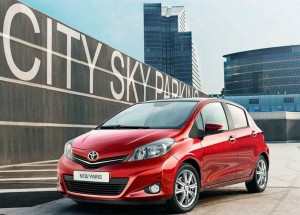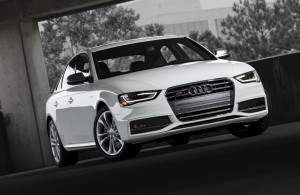Japanese makers – led by Toyota – dominated the 2012 automotive reliability study by influential Consumer Reports magazine.
But the study showed that European makers, notably the Audi brand, made significant gains. So did General Motors, though the other two Detroit makers didn’t fare nearly as well in the annual report by the non-profit magazine.
“Ford had a pretty bad year,” said Jake Fisher, Consumer Reports’ director of automotive testing, noting that the Ford brand fell to 27th among the brands covered by the study while its sibling Lincoln marque dipped to 26th.
Toyota Motor Co.’s three U.S. brands led the annual reliability study, Scion in first place, followed by Toyota and then the Lexus luxury line. Mazda, meanwhile, landed in fourth position. Japanese makers have traditionally led the Consumer Reports study.

Toyota's three U.S. brands topped the realiability list -- though some models, like the Toyota Yaris, still aren't recommended by CR.
But European makers, on the whole, posted notable gains. Audi, one of the luxury brands owned by Volkswagen AG, surged upward by 18 spots and landed in the Top 10 for the first time – notably ahead of Japanese maker Nissan and its luxury brand Infiniti, Fisher pointed out during an appearance before the Detroit Automotive Press Association.
Audi’s upturn was the result of “a lot of blocking and tackling over the years,” said VW executive Marc Trahan, acknowledging that past years’ quality issues were a factor in Audi’s relatively weak performance in the U.S. market.
In contrast to its luxury brand, the Volkswagen marque slipped by two positions, falling to 18th in the new Consumer Reports study.
General Motors posted the biggest gain of any Detroit maker, its Cadillac brand rising 14 spots in the study, to 11th. Fisher suggested GM, on the whole, has been working to improve the quality of existing models and to ensure new products don’t experience the traditional first-year quality problems.
The annual survey is used to offer Consumer Reports readers a guide to vehicle reliability – but also serves as a component for CR researchers to decide which models to recommend or warn against.
Ford had no new models added on CR’s Recommended Buy list – but two taken off the influential guide, the Edge crossover using the maker’s high-mileage EcoBoost engine and the V-8-powered Mustang.
The maker might have done significantly better were it not for two key problems, explained CR auto chief Fisher: its PowerShift transmission, an electrically-shifted, double-clutch manual that has been faulted for drivability issues, and the MyFordTouch and MyLincolnTouch infotainment systems. The latter technology has suffered a variety of issues including ease of use and faulty software that can unexpectedly fail while in use.
“Our reaction is that their data is very much in line with our data,” confirmed Ford spokesman Mark Schirmer. He said Ford is aware of the two key problems and has been trying to address both – stressing that both the transmission and infotainment system issues are being addressed with “software fixes. These are not mechanical problems.”
The study reported problems for Chrysler, as well, though not quite as serious as for Ford. Many of the problems, noted Fisher, were experienced on higher-priced models, such as the V-8 version of the Chrysler 300. The less highly-contented V-6 version of the big sedan, however, remains on the CR Recommended Buy list.
One of the big surprises was the solid performance by the newly reborn Fiat brand, which scored “above average” with its little 500 coupe – and landed on the Recommended Buy list.
Overall, however, Chrysler slipped sharply in the 2012 reliability study.
Among the Japanese, Nissan and Infiniti slipped out of the Top 10, the mainstream brand falling four spots to 13th on the list overall.
Hyundai, which had made major gains in quality in recent years, slipped six positions to 18th overall.
The reliability study was based on responses to an extensive questionnaire submitted by 1.2 million CR readers. This year, about 80% of those replies came online allowing the magazine to ask more extensive questions than the traditional mail survey.
The study looked at scores of potential problems, from engine failures to wind noise to faulty infotainment systems. In contrast to some competing studies, Consumer Reports weighs problems like a broken transmission more seriously than a flaw with a vehicle’s radio. Another closely followed study, J.D. Power’s annual Initial Quality Survey, considers all “problems” equally.
One surprise, revealed Fisher, is that quality levels have remained largely the same over the last five years – a finding in sharp contrast to the results of other studies, such as the Power IQS. But there are big differences, nonetheless.
Where mechanical issues, like an engine failure, dominated the list of problems in the past, today it is more about electronic issues, such as the glitches with MyFordTouch.
And though some analysts contend that the gap between brands has largely closed, the new CR study shows that not to be the case. “There is still a huge span” between the best and the worst, stressed Fisher, noting that while 20% of the owners of the Ford Explorer SUV equipped with a V-6 all-wheel-drive powertrain reported problems, only 1% of the owners of the new Toyota Prius C had quality complaints.
The research chief cautioned that good reliability alone doesn’t mean a vehicle will get CR’s much-sought endorsement. The magazine gave a Not Recommended review to the Prius C, as well as Toyota’s subcompact Yaris. That model also did well in the reliability study, said Fisher, adding that “It does not break down, so it’s really lousy for a long time.”

